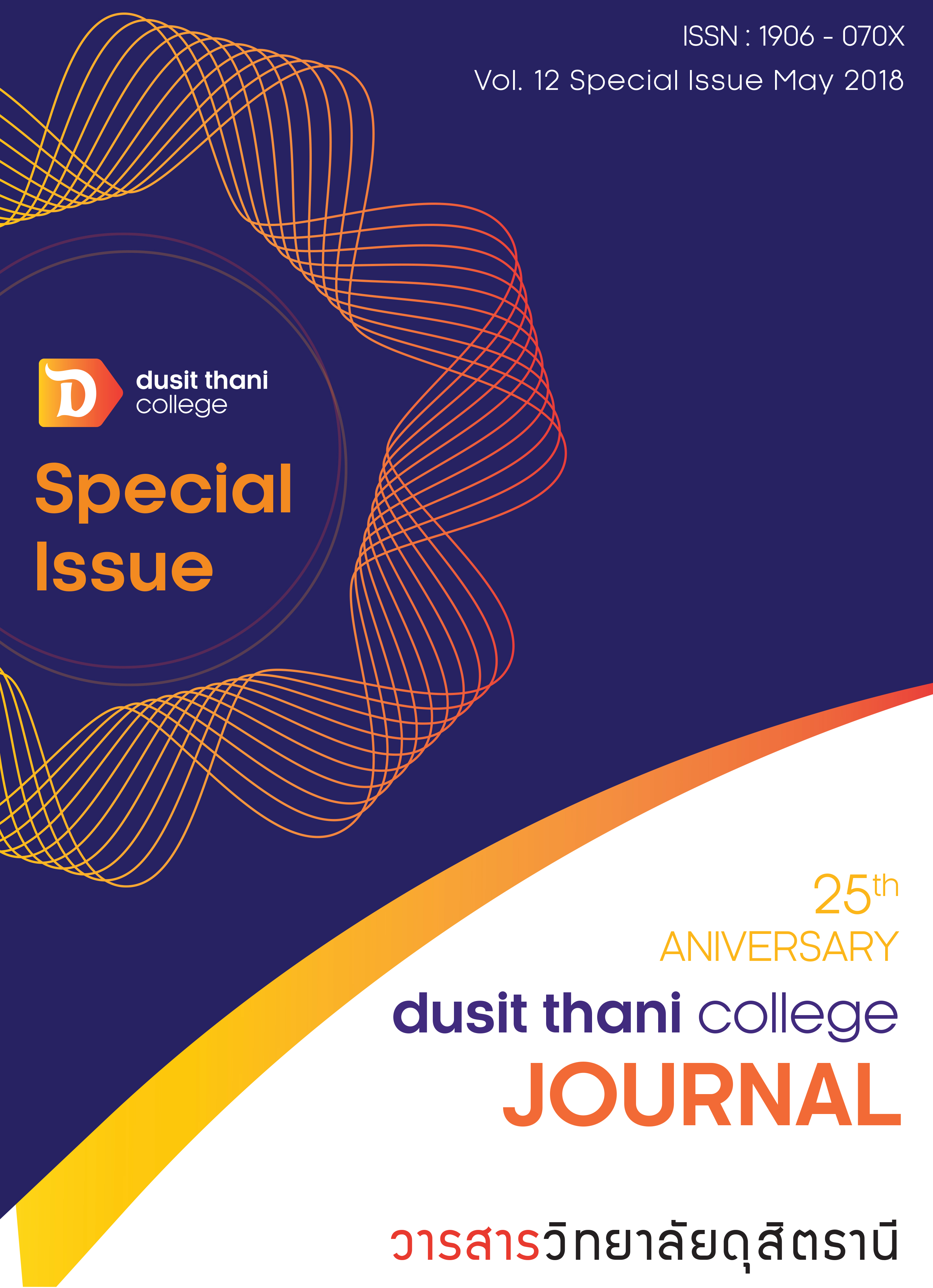การพัฒนาตัวบ่งชี้เพื่อการบริหารจัดการความต่อเนื่องทางธุรกิจการจัดประชุม ภายใต้ภาวะวิกฤต
Main Article Content
บทคัดย่อ
การวิจัยครั้งนี้มีวัตถุประสงค์เพื่อศึกษาการพัฒนาตัวบ่งชี้เพื่อการบริหารจัดการความต่อเนื่องทางธุรกิจการจัดประชุมภายใต้ภาวะวิกฤต ประเภทการวิจัยเชิงสำรวจและพัฒนาเครื่องมือวัดเพื่อการพัฒนาตัวบ่งชี้ โดยอาศัยเทคนิคการวิเคราะห์องค์ประกอบเชิงยืนยันอันดับสาม
ผลการวิจัยสรุปได้ว่า ตัวบ่งชี้ในการบริหารจัดการความต่อเนื่องทางธุรกิจการจัดประชุมภายใต้ภาวะวิกฤตที่พัฒนาขึ้นมีความกลมกลืนเชิงประจักษ์ จากตัวบ่งชี้ทั้งหมด 150 ตัว มีคงเหลือจากการวิเคราะห์องค์ประกอบเชิงสำรวจ 96 ตัว จากการพิจารณาค่าน้ำหนักขององค์ประกอบไม่ต่ำกว่า 0.4 และค่าสัมประสิทธิ์ของความเชื่อมั่นต่ำสุดอยู่ที่ 0.70 และผลวิเคราะห์องค์ประกอบเชิงยืนยันตัวบ่งชี้ เพื่อยืนยันความถูกต้องและความน่าเชื่อถือ ด้วยค่าน้ำหนักขององค์ประกอบ (0.32 และมากกว่า) และพิจารณาจากเกณฑ์วัดความสอดคล้อง ได้แก่ ค่าสถิติไคสแควร์ (178.584) ค่าสัดส่วน (68) ดัชนีที่ใช้เปรียบเทียบแบบจําลองการวิจัย (0.961) ดัชนีวัดระดับความกลมกลืน (0.930) ดัชนีรากกําลังสองเฉลี่ยของค่าความแตกต่างโดยประมาณ (0.137) ดัชนีรากของค่าเฉลี่ยกําลังสองของเศษเหลือ (0.018) ถือว่าอยู่ในเกณฑ์ที่ยอมรับได้
Article Details
นโยบายการพิจารณากลั่นกรองบทความ
- บทความวิจัยและบทความวิชาการทุกเรื่องที่จะได้รับการตีพิมพ์ต้องผ่านการพิจารณากลั่นกรองโดยผู้ทรงคุณวุฒิ (Peer Review) ในสาขาที่เกี่ยวข้อง จำนวน 3 ท่าน/บทความ
- บทความ ข้อความ ภาพประกอบและตารางประกอบที่ลงตีพิมพ์ในวารสารเป็นความคิดเห็นส่วนตัวของผู้เขียน กองบรรณาธิการไม่จำเป็นต้องเห็นด้วยเสมอไป และไม่มีส่วนรับผิดชอบใด ๆ ถือเป็นความรับผิดชอบของผู้เขียนแต่เพียงผู้เดียว
- บทความที่จะได้รับการตีพิมพ์จะต้องไม่เคยตีพิมพ์ เผยแพร่ที่ใดมาก่อน และไม่อยู่ระหว่างการพิจารณาของวารสารฉบับอื่น หากตรวจสอบพบว่ามีการตีพิมพ์ซ้ำซ้อน ถือเป็นความรับผิดชอบของผู้เขียนแต่เพียงผู้เดียว
- บทความใดที่ผู้อ่านเห็นว่าได้มีการลอกเลียนหรือแอบอ้างโดยปราศจากการอ้างอิง หรือทำให้เข้าใจผิดว่าเป็นผลงานของผู้เขียน กรุณาแจ้งให้กองบรรณาธิการวารสารทราบจะเป็นพระคุณยิ่ง
เอกสารอ้างอิง
Christian, M. S., Garza, A. S., & Slaughter, J. E. (2011). Work Engagement: A Qantitative Review and Test of Its Relations with Task and Contextual Performance. Personnel Psychology, 64, 89-136.
Dovidio, J. F., Kawakami, K., & Gaertner, S. L. (2002). Implicit and Explicit Prejudice and Interracial Interaction. Journal of Personality and Social Psychology, 82(1), 62-68.
Green. (2006). Demanding Work: The Paradox of Job Quality in the Affluent Economy. Princeton, NJ: Princeton University Press.
Gupta, M., & Sharma, P. (2011). Factor Credentials Boosting Quality of Work Life of BSNL Employees in Jammu Region. Sri Krishna International Research & Educational Consortium, 2(1), 79-89.
Herbane, B., Elliott, D., & Swartz, E. M. (2004). Business continuity management: time for a strategic role? Long Range Planning, 37(5), 435-457.
Jago, A. G. (1982). Leadership: Perspectives in theory and research. Management Science, 28(3), 315-336.
Kanungo, R. N. (2001). Ethical Values of Transactional and Transformational Leaders. Canadian. Journal of Administrative Sciences, 18, 257-265.
Kotler, P., & Lee, N. (2005). Corporate Social Responsibility: Doing the Most Good for Your Company and Your Cause. Hoboken, New Jersey: John Wiley and Sons.
Kraus, S., Harms, R., & Schwarz, E. J. (2006). Strategic planning in smaller enterprises-new empirical findings. Management Research News, 29(6), 224-344.
Krieshok, T. S., Black, M. D., & McKay, R. A. (2009). Career decision making: The limits of rationality and the abundance of non-conscious processes. International Journal of Strategic Property Management, 75, 275-290.
Lado, A. A., & Wilson, M. C. (1994). Human Resource Systems and Sustained Competitive Advantage: A Competency-Based Perspective. Academy of Management Review, 19(4), 699-727.
Lazear, E. P. (1990). Job Security Provisions and Employment. The quarterly Journal of Economics, 105(3), 699-726.
Matland, R. (1995). Synthesising the implementation literature: the ambiguity-conflict model of policy implementation’. Journal of Public Administration Research and Theory, 5(2), 145-174.
McCartney, G. (2010). Event Management. An Asian Perspective. Singapore: Singapore: McGraw-Hill.
Meyer, G. D., & Heppard, K. A. (2000). Entrepreneurial Strategies - The dominant logic of entrepreneurship. Entrepreneurship as strategy - competing on the entrepreneurial edge. London: Sage.
Northouse, G. (2007). Leadership theory and practice. London, UK: Sage Publications Inc.
Oppermann, M. (1998). Perceptions of convention destinations: Large-half, small-half association meeting planners. Journal of Convention and Exhibition Management, 1(1), 35-48.
Pauchant, T. C., & Mitroff, I. I. (1988). Crisis Prone Versus Crisis Avoiding Organizations Is your company's culture its own worst enemy in creating crises? Organization & Environment, 2(1), 53-63.
Pintrich, P. R. (2000). An Achievement Goal Theory Perspective on Issues in Motivation Terminology,
Theory, and Research. Contemporary Educational Psychology, 25(1), 92-104.
Robbins, S. P., & Coulter, M. (2005). Management. Illinois, IL: Pearson Prentice Hall.
Rose, R. (2011). The Journal of Public Policy in perspective. Journal of Public Policy, 31(3), 235-239.
Rose, R., Beh, L., Uli, J., & Idris, K. (2006). Quality of Work Life: Implications of Career Dimensions. Journal of Social Sciences, 2(2), 61-67.
Sanders, H. (2004). Convention mythology. Journal of Convention & Event Tourism, 6(1/2), 99-143.
Sangpikul, A. (2009). An Overview and Identification of Barriers affecting the Meeting and Convention Industry in Thailand. Journal of Convention and Event Tourism, 10(3), 185-210.
Silvers, R. J. (2008). Risk Management for Meetings and Events. Oxford, U.K: Butterworth-Heinemann.
Smidts, A., Pruyn, A. T., & Van Riel, C. B. (2001). The Impact of Employee Communication and Perceived External Prestige on Organizational Identification. Academy of Management Journal, 44(5), 1051-1062.
Smith, T. M., Hama, K., & Smith, P. M. (2003). The effect of successful trade show attendance on future show interest: Exploring Japanese attendee perspectives of domestic and off shore international events. Journal of Business and Industrial Marketing, 18(4), 403-418.
Snow, C. C., Fjeldstad, O. D., Lettl, C., & Miles, R. E. (2011). Organizing Continuous Product Development and Commercialization: The Collaborative Community of Firms Model. The Journal of Product Innovation Management, 28(1), 3-16.
Stoeber, J. (2011). Perfectionism, efficiency, and response bias in proof-reading performance: Extension and replication. Personality and Individual Differences, 50, 426-432.
Tay, L. (2006). Strategic facilities management of Suntec Singapore international convention and exhibition center. Facilities, 24(3/4), 120-131.
Trosset, C. (2013). Broadening our understanding and assessment of personal and social responsibility: A challenge to researchers and practitioners. New Directions for Higher Education, 164, 23-30.
Watson, M., & Emery, R. T. A. (2004). Environmental management and auditing systems: the reality of environmental self-regulation. Managerial Auditing Journal, 19(7), 916-928.
Zsidisin, G., Melnyk, S., & Ragatz, G. (2005). An institutional theory perspective of business continuity planning for purchasing and supply management. International Journal of Production Research, 43(16), 3401-3420.


